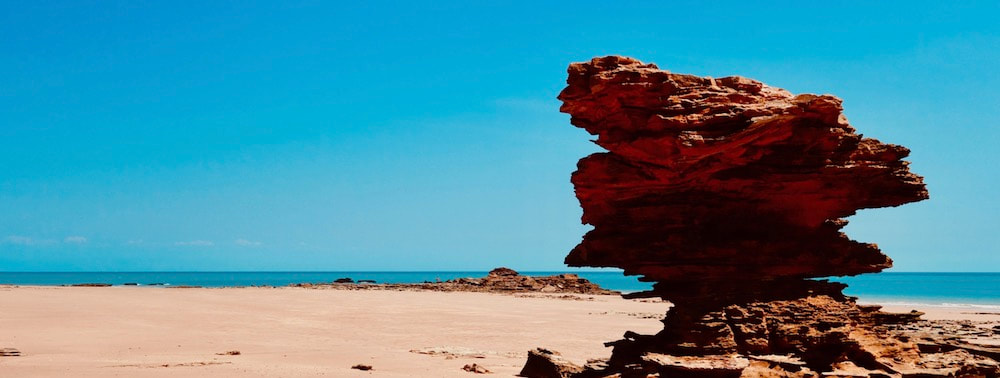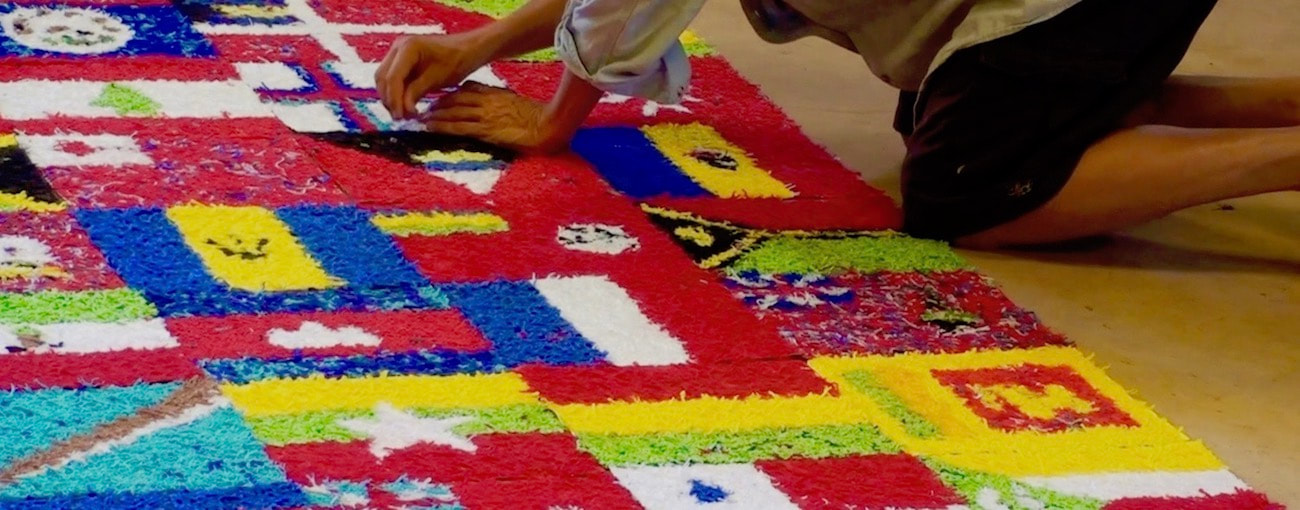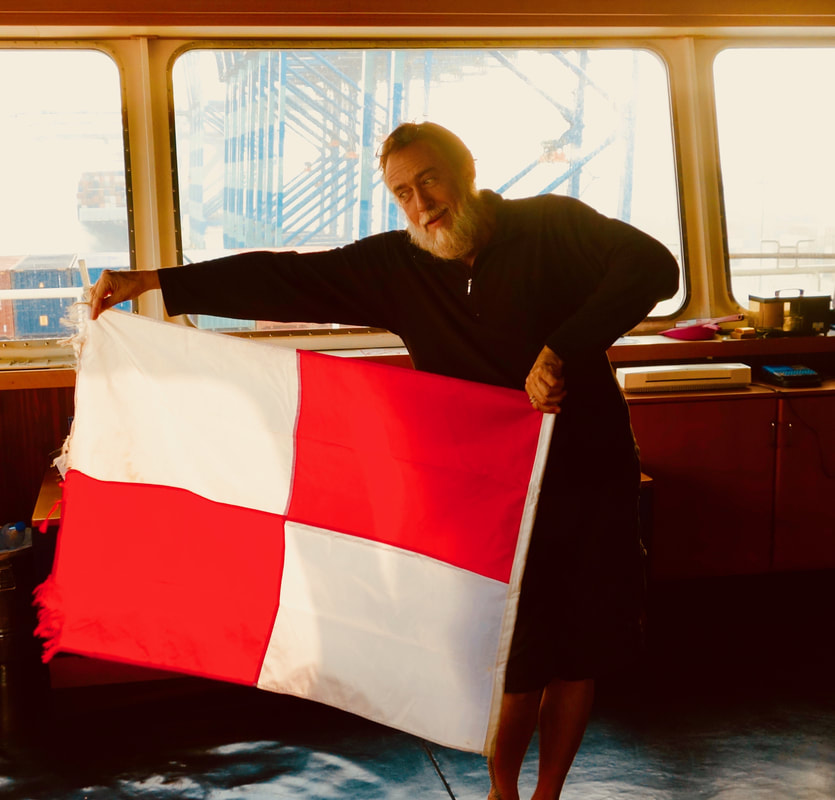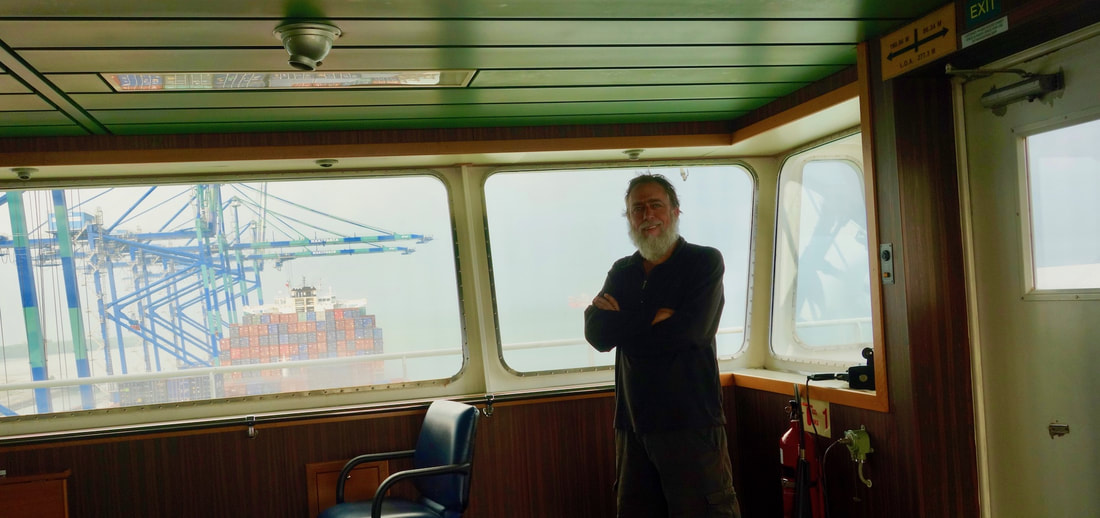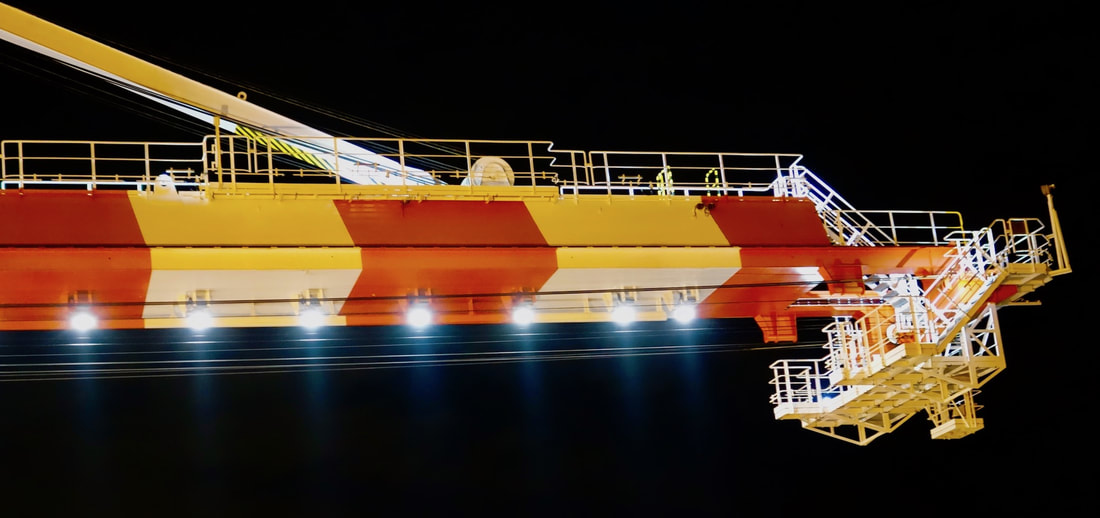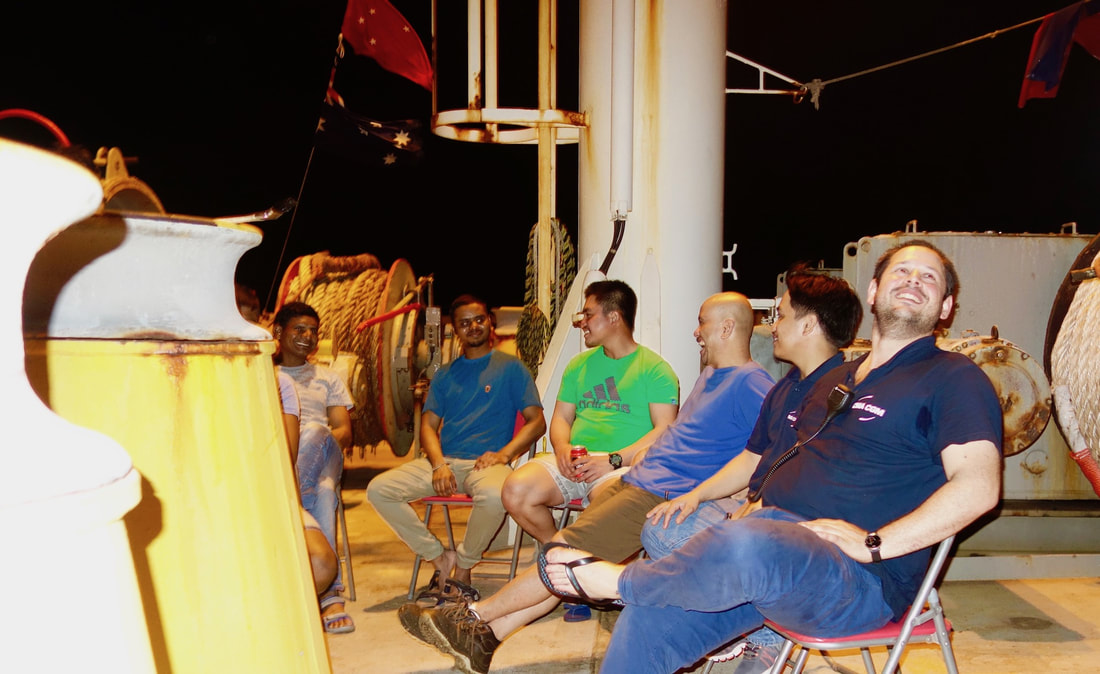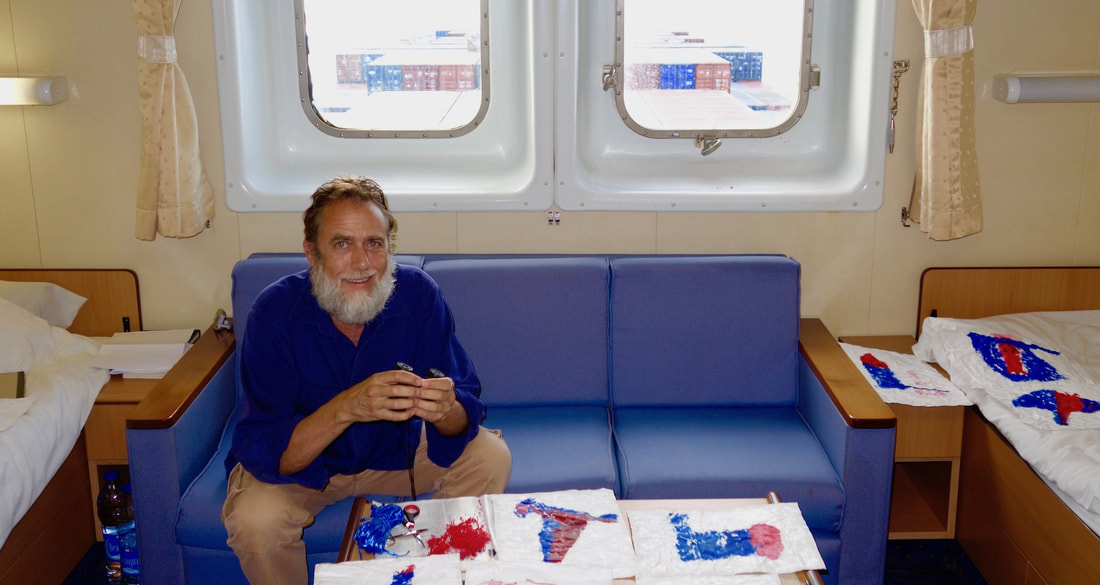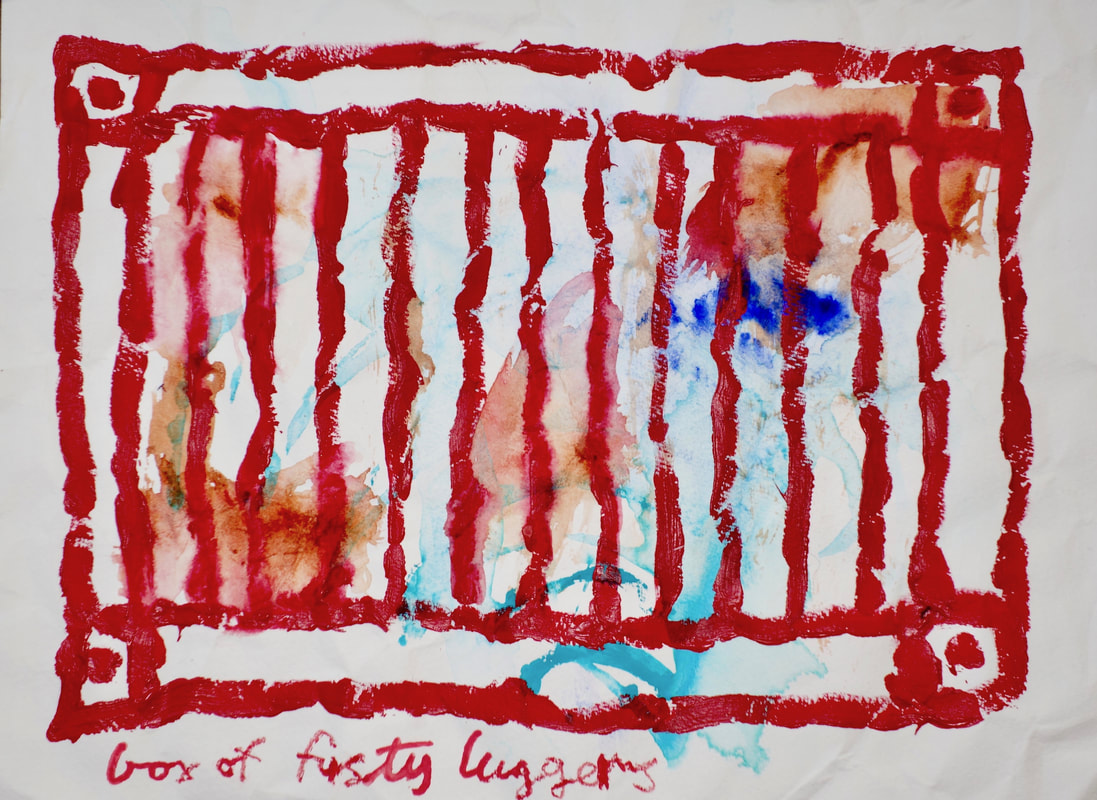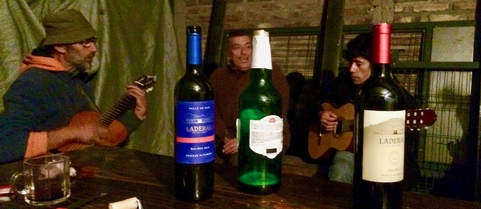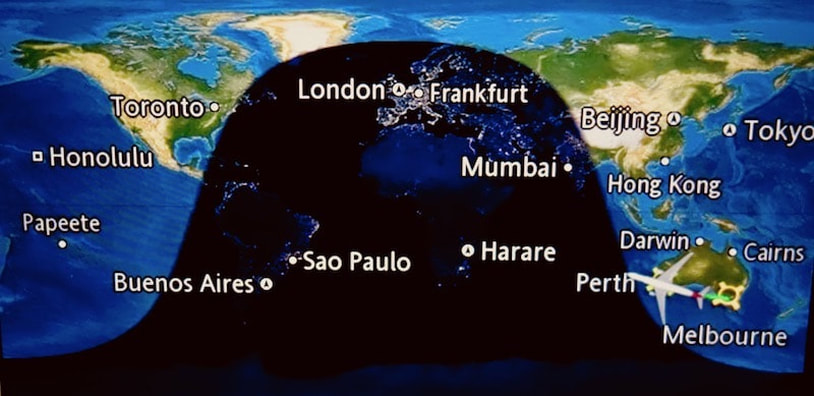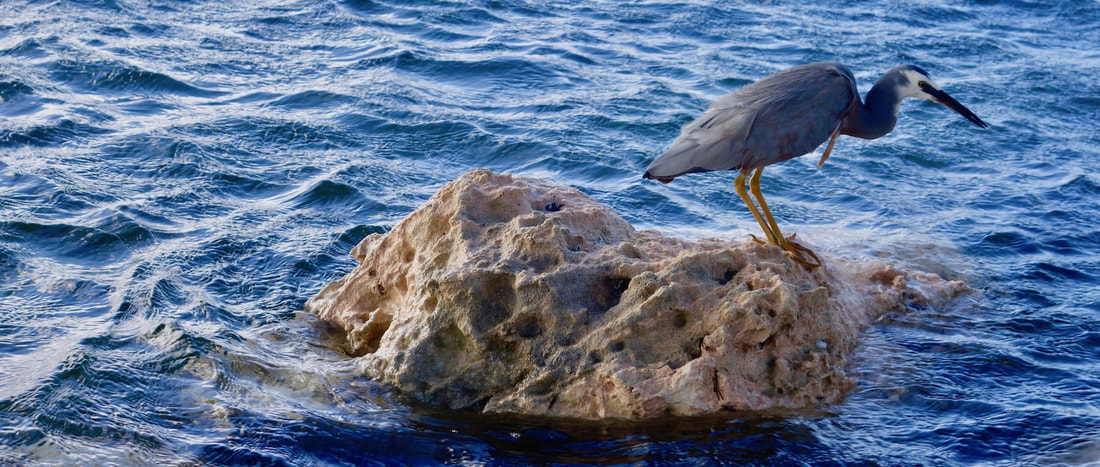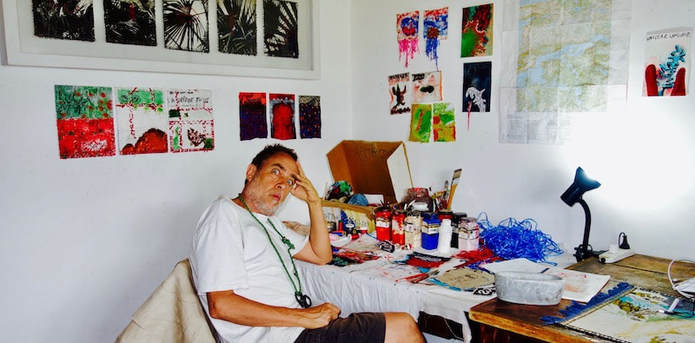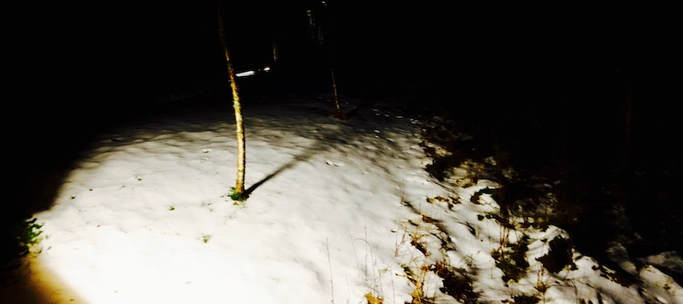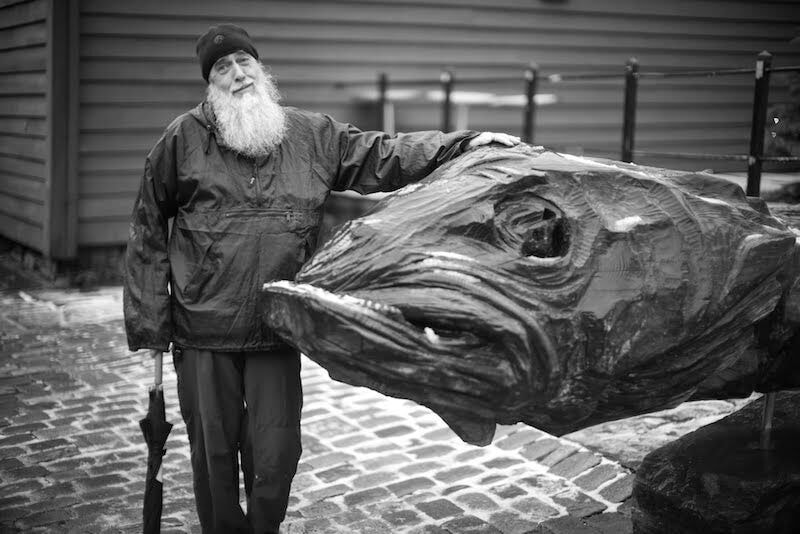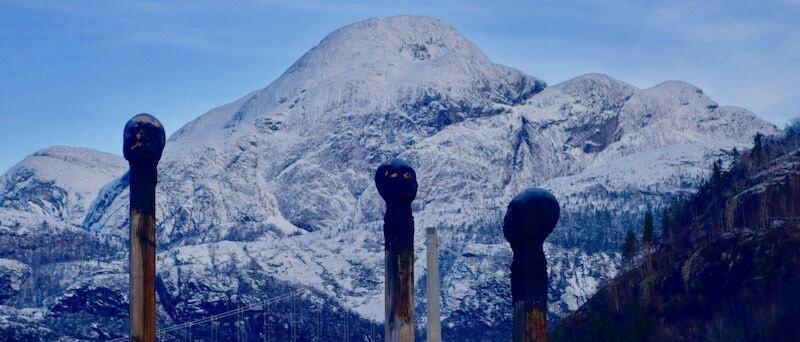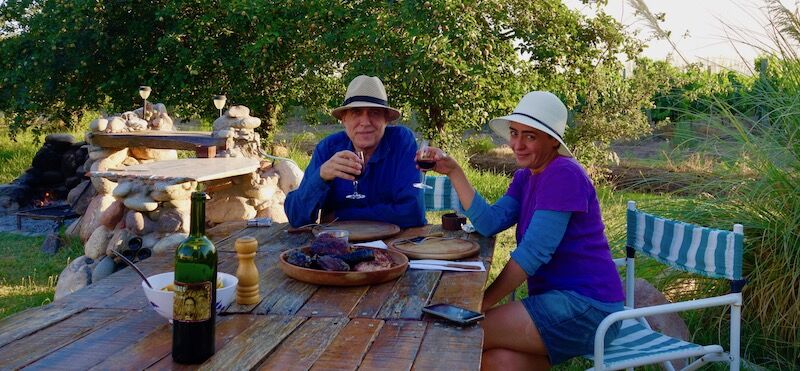|
Things in the studio are streaming along in a sweaty erratic manner with undercurrents of sparkle and zest. I work on a number of different mediums that are all very far from resolved as the brain seems to be somewhat discombobulated here in this extremely hot studio. In fact I find working on five separate strains of work a little bit troppo (temporary insanity due to tropical electrical storms, high temperatures, humidity and large consumption of mangos). “Where am I heading with this?” I ask myself daily. My reply is often in a far too colourful language for this blog. Works on paper are sewn on, scrunched up and then torn, print making ideas are drawn and flogged into submission, mixed media works are splattered then scumbled and smelly oil paint in squeezed into positions that oscillate between perfect clumps of gaudy mud and what looks like dead goo bile. Nevertheless this is what happens in most studios. Experimentation, research, production and finished entities all jostle for attention. Focussed long term chaos is indeed not an adventure for the timid. While this battle rages on in the studio/sauna the short documentary filmed at sea by Malcolm Mckinnon has been completed. I once again thank the Australia Council for the Arts for their help to realise our UNANCHORED WORLD project. A short show reel has been uploaded to this website and Vimeo. To watch the preview please go to https://vimeo.com/305399310 I also wish to thank Malcolm for his considerate and professional manner, his excellent film making skills and his company on the voyage. Cheers also to the maritime soundtracking musicians Marc Constandse and Dan Tuffy! I owe you guys a bottle of Oude Genever or perhaps my personal favourite Schelvispekel. It seems like 2018 is rapidly winding up while preparations for 2019 are already underway in my diary and in my mind. Next year will see me exhibiting in Melbourne, zooming around on trams, catching a few planes, sitting on the edge of a remote mossy cliff pondering the chilly North Atlantic Ocean, eating my favourite pickled herrings, presenting talks to artists much younger than myself, sucking in some hot high-octane, hi-energy L.A smog in a studio in Santa Monica, navigating over the Sierra Mountains and finally engaging in a large chunk of Broome time. Carolina and I may even go to the beach at some stage but only if no peckish crocodiles are spotted paddling about. House and Bloodscape. (detail) A little dwelling sits precariously on a lumpy red substances. Perhaps the red is the blood of family and ancestors all swirling around but simultaneously making your base. Biology forming you as an individual with various inherited traits. A wild ride sometimes but family is family. Or does this home sit on waves of flowing magma. Not the best place to build a home but this is exactly what every home is built on all across Earth. Tectonic plates constantly moving and below that level we are all sitting on a very hot core. A slightly paranoid idea or a reality check? All these thoughts plant family trees deep into geology and acknowledge the precious but fleeting concept of home. Carolina and I presented a small selection of our work at the excellent Turner Gallery in Perth Western Australia during the month of August. Carolinas black and white analogue photographs of assorted palm trees hanging beside my etched pearl shells were greeted with positive responses and some sales which made this PALMSHELLS project definitely worthwhile. When not busy with the show we managed to stroll about Fremantle and a few other Perth suburbs as well and we did the classic bicycle trip around the charming Rottnest Island just off the coast. The little Quokkas nibbling on fresh local pine shoots entertained us as did W.A wine. We also got to meet many fabulous artists living in Perth during the month of August. After packing up the show and saying farewell to the neat and clean city of Perth we headed north back to Broome. We have a number of new plans and projects cooking here but of course many plans are hampered by external factors that are out of ones control. Carolinas homeland of Argentina seems to be often connected with the words "out of control” which makes being far away from there one very good plan.
Broome has warmed up a little since I was here about six weeks ago and the full moon is looking even fuller. Fruit bats arrive in huge tropical gothic flocks, all waiting for the mango season just like us. We plan to avoid crocodiles, jellyfish, sharks and assorted dark lumps in the sea while we wait for the juicy fruit to ripen and we shall also continue to paddle through the waves, ripples and doldrums of life. Paddle on I say... SEA A.i.R A short essay from a self initiated maritime residency. On a large cargo ship I observed a set of small maritime signal flags, used for visual communication across long distances. They say something in a coded manner, a bit like art in some ways. I’ve always been fond of flags but never fond of that nasty, nationalistic excitement often found fermenting and scurrying in circles beneath flagpoles. That “us vs them” attitude is a bit dangerous and dated, so let us avoid fluttering that topic. Flags all over the world are symbols used to communicate, separate and bond, but I saw these little fabric signals as inspiration for the creation of a series of artworks. Art that I make in cabin 705 On deck F of the CMA CGM ROSSINI. It is not new to find artists making art on-board ships. In the busy colonisation period of human history - the early globalisation period, if you like - artists were employed to sketch coastlines and draw everything they encountered, from icebergs to exotic fern fronds, often from the decks of tiny wooden boats. Once photography appeared on the scene this documentation job for artists became obsolete, but now there seems to be a resurgence of artists who find themselves creating art at sea, in all forms and for all sorts of reasons. This cargo container ship is one of a few hundred owned by a large French company. The Rossini is 277 metres long and has a beam (width) of 40 metres. Built in 2004, it has a gross tonnage of 65,730 tons. There are 4,450 (20 foot long) cargo containers or “boxes” full of goods, all securely stacked outside my porthole. Amazingly most items purchased in shops across the world have been on cargo ships just like the Rossini. I am accompanied on this voyage by documentary filmmaker Malcolm McKinnon, a New Zealand passenger on an overland trip from Australia to the UK and the ships crew of 29, comprising French, Filipino and Indian officers and sailors. Some of the crew have an interest in what I make onboard but this is a working ship and time is money. The life of a sailor is not as it was and there is no time to carve intricate exotic scenes on whale teeth anymore. Limited time is spent in ports due to containerisation and robotic machines so that wild sailor shenanigans infamous in ports across the world has all but disappeared. Spare time onboard is spent watching DVDs, working out in the gym and relaxing with the odd celebration. My project slowly paddles forward as I watch, paint, photograph, scumble, glue, sew and somehow connect all my on-board experiences. I draw a set of cargo containers and title them with archaic foul language used by sailors of the past. A BOX OF BESPAWLERS, A BOX OF STAMPCRABS and A BOX OF FUSTY LUGGERS. The terms are mysterious today as are the contents of each cargo container. The crew does know if the goods are toxic, explosive or require refrigeration but not much more. A second series of work on paper deals with flags. I paint and glue a set of fictional flags on damaged paper each titled with a fictional country - THE REPUBLIC OF EXCLUSION and THE KINGDOM OF DOUBT. I flag the idea that nations are constructions, never permanent and a bit over-rated from my perspective. They require continuous mild propaganda, myths, symbols, stories and forgetfulness. History does its best to keep facts alive but nation building is powerful and seductive. We cruise over the sea at an averages speed of 16 knots (approx. 30 kilometres an hour) as I watch the many shades of aquatic blue beneath a very large sky. Since leaving the Port of Fremantle some days ago we have steamed northbound over the Indian Ocean, passing close to Christmas Island, slipping between Java and Sumatra, northwards then westward across the southern zone of the South China Sea to Singapore. Finally, we’ll traverse the Strait of Malacca and dock at the port of Kelang in Malaysia where Malcolm and I shall disembark. That is a distance of 2900 nautical miles or 5365 kilometres as the albatross flies. I first became aware of oceanic art residencies involving long sea voyages in 1989 via the Australian Antarctic Division. I eventually undertook a resupply voyage in the summer of 2000-2001 to Casey Station as part of the Australian Antarctic Arts Fellowship program. My residency involved a sea voyage of three weeks duration that was enormously influential to me; since that trip almost seventeen years ago I have operated as an artist on eleven separate voyages, all within Polar regions. I guess that makes me an “old-hand” at this kind of artful, sea-dog endeavour. Over the past few years a number of other specialised maritime artist-in-residence programs have been set up on cargo container ships, research vessels, private yachts, house-boats and tourist ships. Like all art residencies the interest is high due to the enormous amount of inquisitive and mobile artists across the planet. This interest to engage with waterways is not surprising as the world is mostly covered by water and all humans have an emotive and biological connection. Did not our ancestor’s way back in the good old days live underwater? Personally, the size, the beauty and the lack of law are the main elements that intrigue me about the sea. I also like to watch oceans move. In times of doldrums when that big wet expanse is dead calm but twinkling with sun-rays, or even during a ferocious storm when eighteen meter (60 foot) high waves threatened the ship I was on-board. The sea is always entrancing. Everyone is intimately aware of the magnificent scale of the sea; its force and its impact. Regarding the law of the seas, well, that’s a bit hazier and a lot more fluid. Here I sit today on a Saturday morning in 2018 watching tropical currents flow and hundreds of cargo ships waiting to dock. I am in the international waters just off the east coast of Singapore where in February 1603 the Dutch VOC (Dutch East India Company) captured Santa Catarina: a Portuguese cargo ship full of exotic Chinese porcelain and valuable musk. This event was the catalyst for a young Dutch lawyer by the name of Hugo de Groot being called upon to draft a defence for such a colossal seizure of loot. In Hugo de Groots maritime thesis he states that all nations should be able to use international waters freely for seafaring trade. This document mentions characters like God and is written for “Princes and free states of the Christian world”. It was hardly international in its structure, but it was a beginning and subsequently this thesis titled Mare Liberum became the foundation for global international maritime law. Today oceans outside of national coastal or continental shelf areas are seen as free zones that nobody can own. (Antarctica has similar status under the terms of the Antarctic treaty.) This concept of Mare Liberum or The Free Sea is upheld by the U.N. Convention on the Law of the Sea (UNCLOS); an international agreement currently signed by about 160 nations. I see it as a very complicated set of rules that are impossible to enforce, but it’s the best we have to date. We really need much greater control as to what is actually happening at sea in terms of over-fishing, mining, pirate activity, illegal transportation, future nationalistic claims and pollution. In a nut shell or should I say, in a seashell - 7.6 billion humans make too much mess at sea as well as on land. In my body, which is notably 60% water, I have Dutch sailor genes inherited from my biological father who comes from a long line of merchant sailors, whalers and tug boat owners. Quite possibly one of my seafaring ancestors in the Netherlands, while on leave from a whaling vessel or hoping for a berth on a ship preparing to set sail to the Far East, drank a beer or an Oude Genever (Dutch Gin) in the same café where Mr Hugo de Groot formulated his thoughts on the faraway S.E Asian maritime trade problems. My interest in the sea could actually be pre-me as I may have been born pre-programmed with a set of sea legs. The equatorial sea is vastly different compared to the waters I have crunched through on icebreakers during previous art residencies on-board Polar vessels, but I am still in international waters or the free sea. I open my porthole and let the warm tropical air enter my cabin, while tiny streams of salty body sweat attempt to cool me down. I float on the salty water called the Ocean which is approximately 1.332 billion cubic kilometres larger than I am. Being a minuscule and not that very important human I scan with my little binoculars the infinite blue, the busy port activity and I ponder the sublime. It is easy to be mesmerised and belittled by the awesome sea and mesmerised I am. Artists are sometimes good at seeing the big picture and then presenting their version to others via innumerable styles; some let their emotions run amuck with wild colour and evident passion, while others use direct logical data, manifest in neat mechanical formats. All are merely personal methods of dispatch. Artists at sea can help raise warning flags and inform landlubbers that the sea is a bit sea sick. But here in the Strait of Malacca today it all seems relatively clean and safe, so I won’t need a sword, a solicitor or a sonic stun-grenade just yet. All I require is a tube of sunscreen lotion and another tube of aqua watercolour paint. It is not surprising that I am attracted to the language of the International Code of Signals: a simple graphic, colourful, abstract form of flag communication. When newer technologies are on holiday and one ship wishes to talk to another these small nautical flags can represent and convey most things. All you need to do is wave these flags about in the right order and hope that the other ship can see you and understand what you are on about. Which, in my experience, is very much like making art. Any sailor or Vexillophile will decipher the red and white maritime signal flag as representing the letter U but also if flown alone it will mean – YOU ARE HEADING INTO DANGER. I sometimes fear that we may be. Stephen Eastaugh Strait of Malacca. June 2018 Settling into Broome lifestyle once again. Salt water cowboy territory is familiar to me as I have been visiting this part of the world since 1981. The warmth is not difficult at this time of the year nor is the influx of tourists as I mostly work away in the studio with the odd adventure out into the social world. One social event was the excellent Environs Kimberley Fundraising art auction which attracts a lot of art, a lot of buyers and a lot of fun each year. Over the years it has been most successful and certainly helps this fine cause. www.environskimberley.org.au My recent studio activity involved the completion of many artworks begun on the Indian Ocean. Fuzzy flags, Unclear cargo, Unnational drawings, Chains, knots, ropes and piers, Seasicksea, and Vexed vexilla. (Troubled flags) Other works fermenting in the brain which were spawned on the ship I try to squeeze out into the physical realm. All that adds up to a fairly productive time here in the green shed studio but the big smoke is calling me. Perth is 2,239 kilometres south from Broome and this is where I reunited with Carolina. After the very complicated process of leaving Argentina and the equally complicated process of entering Australia, Carolina will be in need of a stiff drink I imagine. Borders become more tricky each year it seems. Not surprising really as the last time I looked there were 7,639,373,111 people living on this funny little blue ball. Carolina and I shall exhibit together while down south. PALMSHELLS Caroline Furque (Argentina) + Stephen Eastaugh (Australia) The title of this small show joins botanical photographic work of Carolina Furque with the pearl shell work of Stephen Eastaugh. Black and white images of vegetation, taken in far flung places hang beside pearl shells etched with obscure designs sourced from extensive travels.
These two bodies of work are also joined by the fact that Carolina and Stephen are partners who met in France in 2001. The couple have travelled widely together since then and I do mean widely (Argentina, Cambodia, Iceland, Malaysia, Greenland, Morocco, Vietnam, Netherlands, Mexico, Germany, Egypt, Chile, Scotland, Hong Kong, Russia, Singapore, Macau, Uruguay, Japan and Australia) August 10 to September 8th. Turner Galleries - 470 William street, Northbridge. Perth. W.A. 08 9227 1077 Besides evolutionary/biological and historical connections I have with the sea I do see the sea as a primary element of this planet of ours. Earth’s surface is covered by 71% of water, we are made up of roughly 60% water, and carbon life as we know it requires liquid water to occur. From a human perspective, you can’t get more primary than that. Oceans also connect the separate continents, lands and nations. The rabid capitalistic democratic order that currently frames most human activity on earth today uses the Oceans as a means of transporting stuff from A to B. From grower to buyer or from raw material to finished product. Business as usual on a global level. Massive cargo ships perform this operation. In fact, about 15,000 ships continually sail around the seas transporting everything from tractors to plastic scissors. I was on one such ship. The CMA CGM ROSSINI a 13 year old ship, 278 metres in length which sails under a French flag and was transporting 4450 cargo containers from Australia to S. E Asia. It is the job of 1.3 million sailors across the planet to help move all these boxes of stuff about. This industry alongside other transport modes, communication via digital technology and the international financial world are elements that enable globalisation to continue and expand in such a rapid manner. Globalisation refers to the crystallisation or melding of the entire world into a single place. A unification of human activity if you like. Hopefully, good, fair and friendly activity rather than evil, greedy and stupid activity. We can only hope! The shipping world is hard core in its capitalist methods as it operates under extreme weather conditions in an unstable, fickle world market that is based on an illogical exponential growth model. The unusual FOC or Flags Of Convenience system used by shipping companies to source cheap labor is an example of this. Finding ships made in Romania, owned by American companies, with European officers and Filipino crews which are register in land-locked countries like Bolivia or Mongolia is very odd indeed. I don’t wish to delve into too much geopolitics as I am out of my league being a simple trans-national visual artist who was luckily given the opportunity to observe this incredible industry from cabin 705 on Deck F. This global maritime transport industry is partly hidden behind seemingly chaotic but highly controlled ports and it is also difficult to observe what happens across the enormous expanses of our dark oceans and blue seas. What I do know is that a great deal happens 24 hours a day, 7 days a week. For instance; each year approx.120,000,000,000,000 cargo containers are moved across international waters where the law is as wobbly as the seas upon which all these cargo ships float. However complicated the industry is it certainly is fascinating and this trip did enable me to return to the sea to make art as I traveled slowly from one continent to another. I thank the officers and crew of the ROSSINI for letting myself and Malcolm experience such a world. Big thanks also to the Australia Council for the opportunity to explore and work on that… “large blue wobbly thing where the mermaids live”. UNCLEAR CARGO (BOX OF FUSTY LUGGERS) WORK ON PAPER. 2018
The last little party I went to in Argentina was at the home of some excellent friends, Coyote and Lula live in La Consulta and are always great to catch up with. It was a classic Argentine evening. Surrounded by vineyards we sat under the Andes mountains drinking red malbec wine, feasting on an Asado (meat bbq), the guests played guitars and sang in that sad but strong tango style. It was a special night of laughs and fun in many ways but also it was a farewell as I have no idea when I shall return there. Suddenly I found myself looking at maps like this on the back of economy seats and out of small windows I saw the tops of clouds obscuring the large complicated world below me. Once over the pacific I spent some days running about Melbourne and I believe I saw people and did stuff there but I am really not that certain. Currently I am in Perth Western Australia. A very pretty and neat city with ample going on, as it now has 2.2 million inhabitants. There seems to be a lot of building going on and I wonder who shall pay for all that but it also has a fantastic climate and much more going for it. The native vegetation I love and the birdlife is wonderful, charming gardens, a strong art world, sporting activity galore as this is the religion of many Australians and at each dusk and dawn I watch smoke from controlled bushfires colour the sky over the Swan river where people catch prawns and crabs and zip about in all types of sea-craft.
In Perth, I managed to do a small artist talk at the Edith Cowan University for a group of art students and visit some galleries but I will not see much more this time as I must put on my maritime attire and consider the Indian Ocean for a bit. “Ship Ahoy” as they say. Beside the excellent wine and meat to be found and consumed here in Argentina, I have discovered a brilliant Argentine Gin called Apostoles. (https://www.apostolesgin.com) Made with Juniper, Yerba Mate, Pink Grapefruit, Peppermint and my favourite; Eucalyptus! Perfect on ice in a garden watching electrical storms above the Andes or perhaps while on a road trip somewhere or as a toast to say farewell Argentina. OFF-CENTERED - a wandering sketch I was born in a marginal place located at the southern bit of the world currently called Australia. Far from the busy northern hemisphere where most of the human population live and where most power bases currently reside. The past years I have spent a long time in Argentina, another large but comparatively quiet fringe-land in the south and I have also spent close to two years living in Antarctica, which is as remote as you can get on this planet. Further-more, I keep moving like some lost soul avoiding capture from mysterious invisible evil authorities. My nomadic behaviour has kept me slightly off the radar and in-transit for over 30 years. I often live with extended geographical space between myself and people I know. This has not turned me into a sad lonely hermit nor anti-social, as I am indeed a social person when I need to be but I have been afar and I have certainly missed a few birthday parties. It seems I find myself in a place called Peripheral. A place near Border and just down the track from Away. I make art in Peripheral. It is far from the Center and difficult to get to but the view is lovely and the air is usually nice and clean. There is a certain amount of freedom here as the weight of history seems not too heavy, competition is not too obvious, pressure and greed are kept at a healthy distance, gossip is only faintly heard and the Center often seems like a fuzzy mirage. Interaction is not very strong here and networking is extremely limited. To live and operate here one must be self-sufficient, self-motivated and self-disciplined as well as selfish, self-obsessed and one must also be able to take “selfie” photographs to upload onto the internet so people in distant lands don’t forget who you are. Peripheral is a place people like to visit in order to recharge their batteries but many don’t wish to live here as it is far away from the so called “action”. Here in Peripheral you must make your own action. From this outlying situation, you can watch from a distance the intense action or hear loud noises from the Center but you cannot influence or play a role, as you are not physically there nor directly engaged with the central commotion. You are on the exterior looking in. Occasionally you wonder how all those complicated Center activities will affect you and in what manner. It can be argued that everyone is now very well connected in this globalized, hi-tech information age of ours, therefore nowhere is faraway. Yes, it is true that if money is available one can jump on a plane and travel from one side of the planet to the other in less than a day and it is true that many of us have been able to communicate rapidly over massive distances for decades but there are still the inner sanctums and the outer areas. Those hot spots and the icy wastelands. Sometimes here in Peripheral you wonder where you have disappeared to and you must check your position in a mirror and of course you always locate yourself right smack, bang here in the world. Centralized each moment, wherever you may be until the day you die and then all those elements currently called ‘you’ dissipate outwards to meld with outlying regions. If you are living in Peripheral some bits of you will probably get to the Center eventually and if you are at the epicentre then what was you will spread to the far fringes. Everything likes to move and nothing is really at the Center nor near Peripheral forever. This is why I like maps as they help us situate ourselves in this flowing magma of existence. I ponder maps of all sorts whether I am in Peripheral on my way to Center or if I am in Center and heading out “bush.” It is ironically stabilizing for me to know I am moving as well as comforting to be aware of which direction I am moving towards. Cartography can ease those off-centred feelings of dizzy disorientation but the real trick for me is to locate that feeling of being remotely centred wherever you find yourself. There is a great deal for me to do over the next weeks as an Australian Council for the Arts grant now enables me to implement a self-initiated maritime art residency on-board a cargo container vessel in mid. May.
I shall undertake a sea voyage from Western Australia to S.E Asia accompanied by film maker Malcolm McKinnon. You can track us if you go to this link – https://www.marinetraffic.com/en/ais/details/ships/shipid:171681/mmsi:226327000/vessel:CMA%20CGM%20ROSSINI Bon voyage. Portrait by Geir Jordahl. Bergen. Dec. 2017. SOON WE ARE LANDSCAPE. Stephen Eastaugh. 2017. (Norway) Matchstick men – Wolfgang Stiller Studio portrait by Kate Jordahl. Dale i Sunnifjord. Dec. 2017 I said goodbye to my studio at NKD in Norway, some tall matchstick-men, European friends and a very large dried fish that I befriended in Bergen then I ran away from a white, cold and wet Euro winter. I had intended to visit Ireland but for a number of reasons out of my control I headed back to Argentina. It took 60 hours of travel to get from Dale i Sunnifjord to La Consulta. (BGO Bergen - CPG Copenhagen - LHR London - CDG Paris - GRU Sao Paulo - MDZ Mendoza.) Really, that is not so many hours of travel but long-haul economy air travel with lots of stopovers via many major international hub airports is a bit painful I must say. A slow boat would have been more to my liking.
A few incidents during this 60-hour epic trip. I was stuck in a faulty insane talking elevator, there was a very rough and almost scary landing at San Paulo airport and I spotted plane spotters at Heathrow airport. These characters must be the modern form of birdwatchers who get enjoyment from watching and listing the numerous varieties seen. Armed with binoculars, iPads, and petrol station coffee, plane spotters scan the skies and airports for metallic birds to add to their lists. Does anyone have any idea why they do this? I have a love/hate relationship with air travel and airports these days. I do not get motion sickness (air, road nor sea) but I do now get a nasty strain of APS or AirPort Sickness which is an ailment caused by non-motion or movement at snail pace. This sickness appears after being trapped in too many long slow lines of passengers each being personally searched, scanned and processed in order to board aircraft. APS is especially damaging if one is impatient, tired, hung-over or running late. It is stress, body clock complications and boredom all accelerated and subsequently causing acute grumpiness, rudeness and occasionally totally berserk behaviour. Symptoms include spraying dozens of brands of duty free perfume samples onto ones exposed skin in order to construct a unique and personal aromatic cloud surrounding the body and staring Zen-like at inanimate objects for far too long. I found myself in a semi-hypnotic state intensely watching a plastic pot plant while sitting in the lounge of terminal 2, gate 41 at San Paulo (GRU) airport. This nylon decoration was a fluorescent green shrub the size and shape of an elephant turd but pretending to be a small bamboo grove I think. It was truly mesmerizing due to my intense bout of APS contracted during the trip. Luckily a kind fellow passenger / sufferer clobbered me across the head with a hello kittytravel pillow which knocked me out of my unhealthy trance. Then all of a sudden, I was in Argentina… Argentina is a place where the term “out of control” seems rather popular. The country often reminds me of an assortment of TV soap operas where over-acting, a lack of logical thought, bad planning and a preoccupation with appearances are the building blocks of each scene. Often on high volume and often high-level emotions perform some sort of excitable dance with corruption, tears and power plays. In comparison, I must act like a pathetic tame robotic butler. So, I return to the fashionable pandemonium of South America or shall I call it – heated passion? It is both of course so I prepare myself by watched the excellent 2014 movie titled - Wild Tales (Relatos salvajes) which displays some aspects of Argentinean culture, in fact it broadly displays modern humans doing their best at not being their best. Don’t get me wrong I do find many aspects of Argentina to be grand and impressive and I very much hope that it reinvents itself in some other form as soon as possible. Now it is summer in the southern bit of the world so bye bye beard. |
